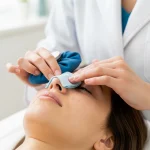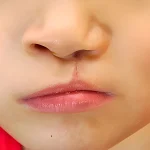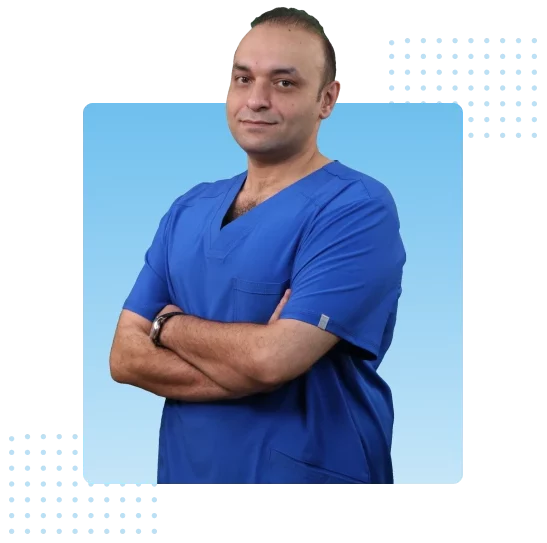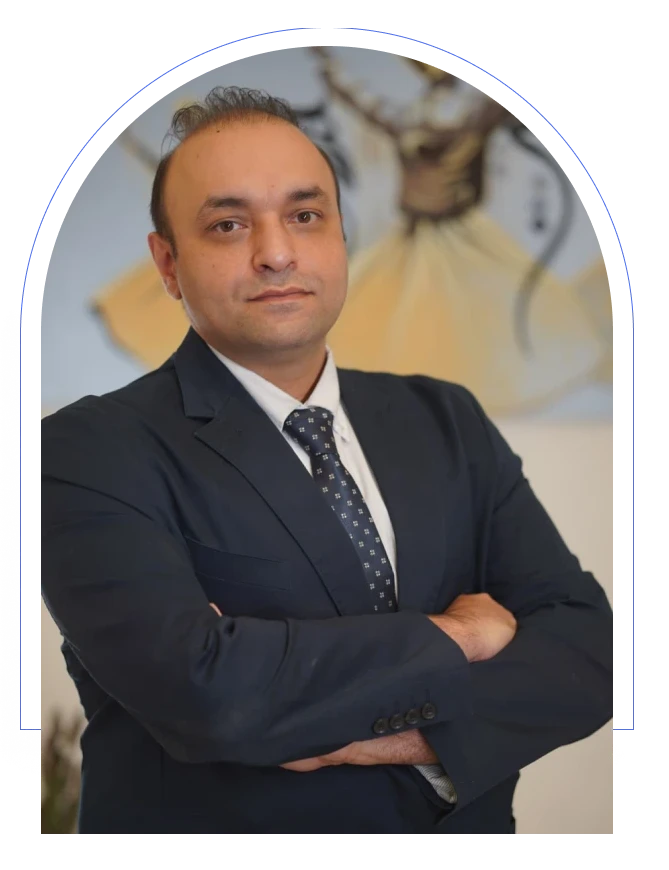The eyes are often the first thing people notice about us, but they are also one of the first areas to show signs of aging. If you’ve ever looked in the mirror and felt that your eyes make you look more tired or older than you actually feel, you might be wondering what your options are. This leads many to a key question: What is blepharoplasty?
Simply put, blepharoplasty, or eyelid surgery, is a cosmetic procedure designed to remove excess skin, muscle, and sometimes fat from the upper and lower eyelids. It’s a targeted surgery that addresses puffiness, drooping lids, and under-eye bags, effectively rejuvenating your appearance and restoring a brighter, more alert look. This isn’t about changing who you are; it’s about refreshing your appearance so your eyes truly reflect your inner vitality. This guide will explore everything you need to know about how this transformative procedure works.
Blepharoplasty at a Glance
| Aspect | Description |
| What is it? | A cosmetic surgery to rejuvenate the eyes by removing excess skin and fat from the upper and/or lower eyelids. |
| Primary Goals | To create a more youthful, alert, and rested appearance; to improve vision obstructed by drooping eyelids. |
| Common Corrections | Hooded or drooping upper eyelids, puffy under-eye bags, fine wrinkles and excess skin on the lower eyelids. |
| Types of Surgery | Upper Blepharoplasty (for the upper lid), Lower Blepharoplasty (for the lower lid), or both combined. |
| Anesthesia | Typically performed under local anesthesia with sedation, or sometimes general anesthesia. |
| Recovery Time | Social downtime is about 7-10 days. Most swelling and bruising subsides in 1-2 weeks. |
| Results | Long-lasting and often permanent, especially the removal of under-eye fat bags. |
What Can Blepharoplasty Achieve? The Applications of Eyelid Surgery
While often categorized as an anti-aging procedure, the applications of blepharoplasty extend beyond just turning back the clock. It’s a highly versatile surgery that offers both significant cosmetic enhancements and, in some cases, important functional benefits. A skilled surgeon can use blepharoplasty to address a wide range of concerns related to the eye area.
Cosmetic Applications:
- Correcting Droopy or Hooded Upper Eyelids: The primary cosmetic goal for many is to remove the excess, sagging skin on the upper eyelid that can create a heavy, hooded appearance.
- Eliminating Under-Eye Bags: Blepharoplasty is exceptionally effective at removing or repositioning the fat deposits that cause puffy bags beneath the eyes.
- Smoothing Wrinkles and Fine Lines: By removing excess skin and tightening the remainder, the procedure can significantly smooth out crepey skin and fine wrinkles on the lower eyelids.
- Creating a More Rested and Alert Appearance: The cumulative effect of these changes is a brighter, more youthful, and naturally refreshed look. Patients often find that they no longer look perpetually tired or sad.
Functional Applications:
- Improving Vision: In more severe cases, the sagging skin of the upper eyelid can hang over the eyelashes and obstruct a person’s peripheral vision. Upper blepharoplasty can remove this obstruction, leading to a direct and significant improvement in the field of vision. This is a key reason why the procedure is sometimes deemed medically necessary.
- Reducing Skin Irritation: The folds created by excess eyelid skin can sometimes rub together, leading to chronic skin irritation, rashes, or discomfort. By removing these folds, the surgery can alleviate these issues.
Types of Blepharoplasty: Targeting Your Specific Concerns
Blepharoplasty is not a one-size-fits-all procedure. It is specifically tailored to address the unique concerns of either the upper eyelids, the lower eyelids, or both. Understanding the difference is key to knowing what the surgery can accomplish for you.
Upper Blepharoplasty: Restoring a Youthful Eye Contour
Upper eyelid surgery is designed to combat the effects of aging and genetics on the area above the eyes. Over time, the skin loses elasticity and the underlying muscles weaken, causing the upper eyelid to droop and sag. This can result in a “hooded” appearance that makes the eyes look smaller and can create a tired or aged expression.
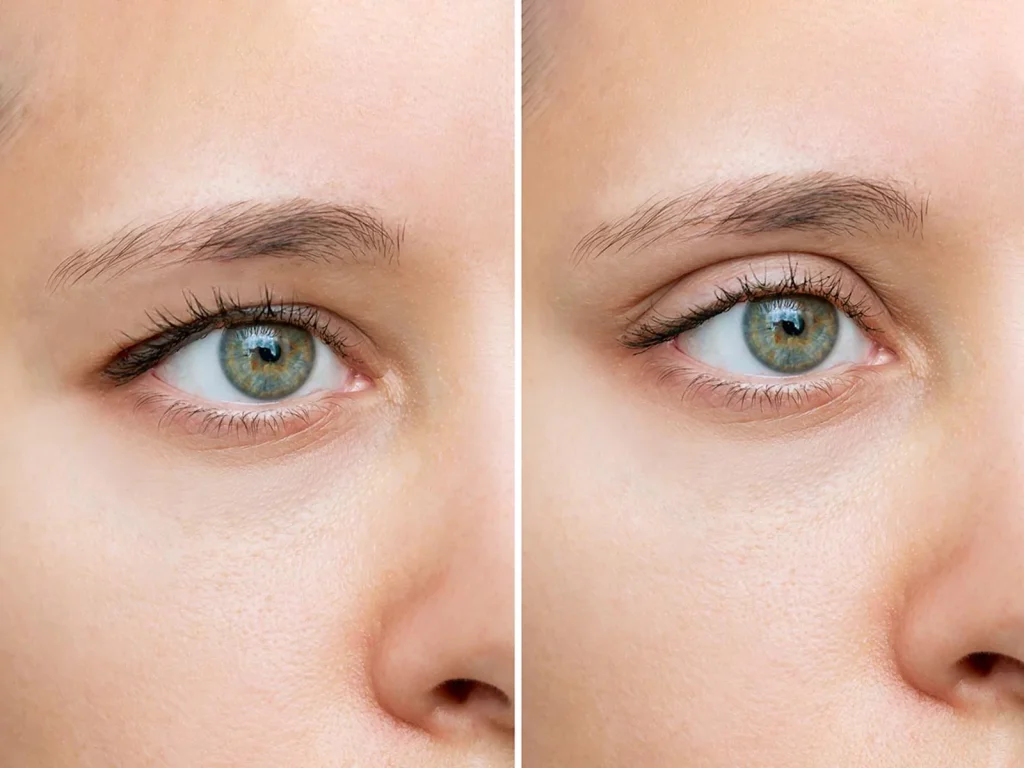
During an upper blepharoplasty, the surgeon makes a precise incision within the natural crease of the eyelid. This placement is strategic, as it ensures the resulting scar is exceptionally well-hidden and virtually invisible once healed. Through this incision, the surgeon removes a carefully measured amount of excess skin, tightens the underlying muscle if necessary, and removes or repositions small pockets of fat. The result is a smoother, more defined upper eyelid contour that “opens up” the eye area for a more youthful and alert appearance.
Lower Blepharoplasty: Erasing Under-Eye Bags and Wrinkles
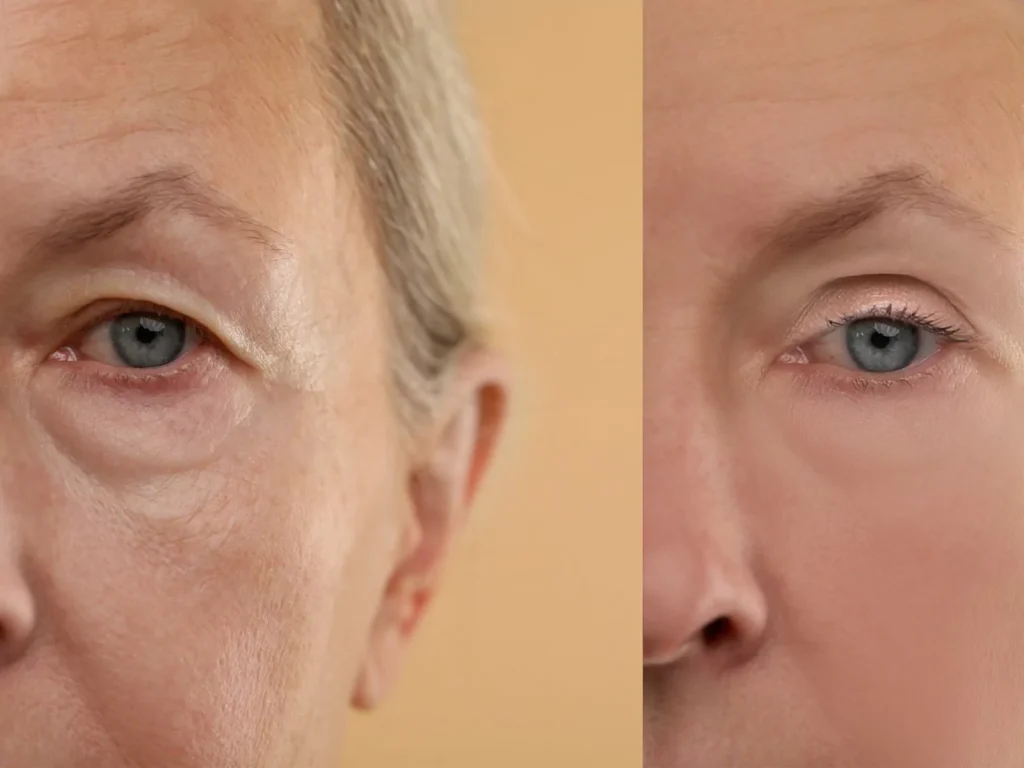
Lower eyelid surgery primarily targets under-eye bags, puffiness, and fine wrinkles. These issues are often caused by fat pads beneath the eye moving forward and bulging, as well as the thinning and stretching of the lower eyelid skin.
The surgical approach for lower blepharoplasty can vary. One common technique involves an incision made just below the lower lash line. This allows the surgeon to remove excess skin and access the underlying fat pads, which can then be skillfully removed or repositioned into the hollows under the eyes (the tear troughs) to create a smooth, seamless transition from the eyelid to the cheek.
Another advanced technique, known as a transconjunctival blepharoplasty, involves an incision made on the inside of the lower eyelid. This method is ideal for patients whose main concern is excess fat, without much loose skin. Because the incision is internal, this approach leaves no visible external scar whatsoever.
What is the Best Age for Blepharoplasty?
A common question is, “What is the best age to get eyelid surgery?” The truth is, there is no single “best age.” Candidacy for blepharoplasty is determined by a person’s individual anatomy, genetic predispositions, and personal concerns, not by their chronological age.
While it is most commonly performed on patients in their 40s, 50s, and 60s to address age-related changes, it’s not unusual for younger patients to seek the procedure. Some people in their 20s and 30s have a genetic predisposition to developing heavy, hooded eyelids or prominent under-eye bags. For these individuals, who have been bothered by these features their entire lives, undergoing blepharoplasty at a younger age can be a highly effective and satisfying solution.
Ultimately, the right time for blepharoplasty is when the cosmetic or functional issues around your eyes begin to concern you. The most important factor is being in good overall health and having realistic expectations for the outcome of the surgery.
Surgical vs. Non-Surgical Blepharoplasty: Understanding Your Options
While surgery offers the most dramatic and long-lasting results, there are also non-surgical treatments that can provide modest improvements for the eye area. Understanding the difference is crucial for setting realistic expectations.
Non-Surgical Alternatives
For those who are not ready for surgery or have very mild concerns, some non-invasive options exist. These can include:
- Dermal Fillers: Injectable fillers containing hyaluronic acid can be carefully placed in the tear trough area to fill in hollows and create a smoother transition under the eye, temporarily masking the appearance of bags.
- Botox®: This injectable can be used to create a subtle lift in the eyebrows (a “Botox brow lift”), which can, in turn, make the upper eyelids appear slightly less heavy.
- Laser Resurfacing: Laser treatments can help tighten the skin and improve its texture and fine lines around the eyes by stimulating collagen production.
- Radiofrequency (RF) Microneedling: This procedure also boosts collagen to help tighten mildly loose skin.
It’s important to note that while these treatments can be effective for minor issues, they cannot remove excess skin or fat. Their results are temporary and require ongoing maintenance sessions.
The Surgical Approach
Surgical blepharoplasty remains the gold standard for significant and lasting eyelid rejuvenation. It is the only method that can physically remove excess, sagging skin and permanently address bulging fat pads. While it involves a recovery period, the results of a surgical blepharoplasty are far more transformative and can last for many years—often for a lifetime in the case of lower eyelid bags.
Your Guide to Blepharoplasty Recovery and Aftercare
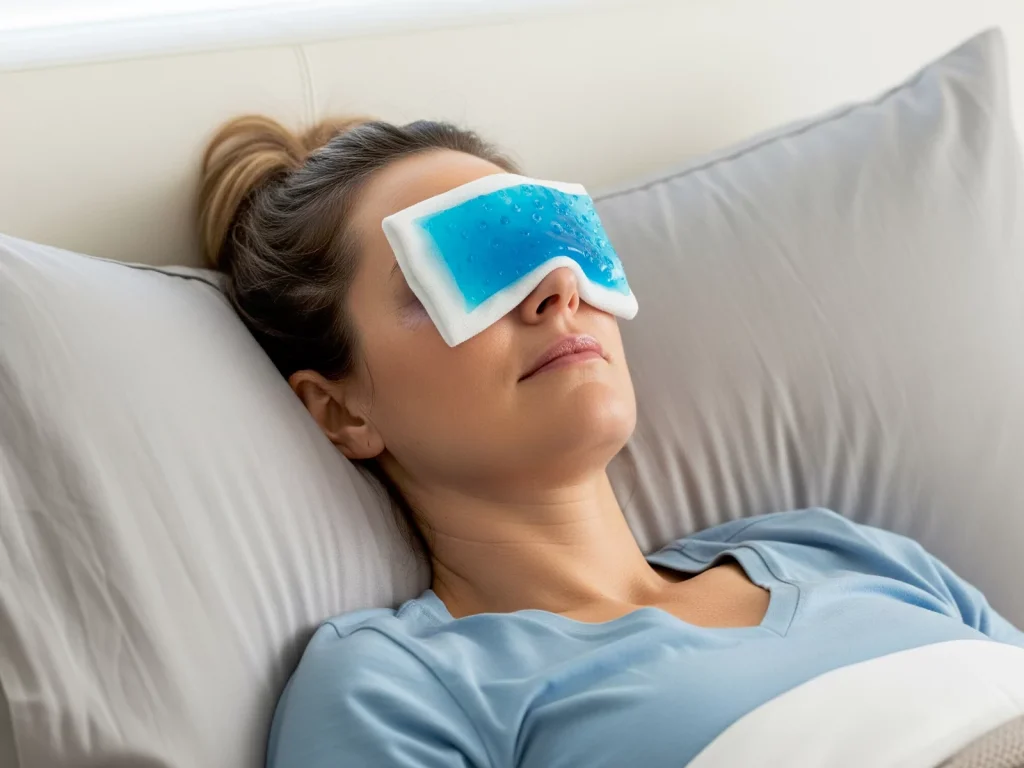
A smooth and successful recovery is just as important as the surgery itself. Following your surgeon’s aftercare instructions diligently is key to achieving the best possible result and minimizing complications.
Essential Post-Op Care Tips
The initial recovery period typically lasts about one to two weeks, during which you can expect some bruising and swelling.
- Rest and Elevate: For the first few days, rest is crucial. Keep your head elevated at all times, even while sleeping, by using two or three pillows. This will significantly help in reducing swelling.
- Use Cold Compresses: Applying cold compresses (such as a clean cloth with ice or a bag of frozen peas) to the eye area for 10-15 minutes at a time during the first 48 hours can help minimize swelling and bruising. Do not place ice directly on the skin or eyelids.
- Keep the Area Clean: Follow your surgeon’s instructions for gently cleaning the incisions. You may be prescribed an antibiotic ointment to apply.
- Avoid Strenuous Activity: You must avoid all strenuous activities, including exercise, bending, and heavy lifting, for at least two to four weeks, as these can increase blood pressure and lead to bleeding.
- Protect Your Eyes: Wear dark sunglasses when you go outside to protect your eyes from the sun and wind. Your eyes may be more sensitive to light initially.
- Don’t Wear Contact Lenses: You should avoid wearing contact lenses until your surgeon gives you the okay, as this could irritate the eyes. Stick to wearing your glasses instead.
What to Eat After Blepharoplasty?
Your diet can play a surprising role in your recovery by helping to reduce inflammation and provide the nutrients your body needs to heal.
- Stay Hydrated: Drink plenty of water. Proper hydration is essential for healing and helps to flush out toxins.
- Eat Anti-Inflammatory Foods: Incorporate foods rich in vitamins and antioxidants, such as berries, leafy green vegetables (spinach, kale), and colorful fruits. Pineapple and papaya contain enzymes that can help reduce bruising.
- Choose Lean Proteins: Protein is vital for tissue repair. Opt for lean sources like chicken, fish, beans, and lentils.
- Reduce Salt Intake: A high-salt diet can cause your body to retain water, which can worsen swelling. Avoid processed foods, canned soups, and salty snacks during your recovery.
How to Choose the Right Blepharoplasty Surgeon
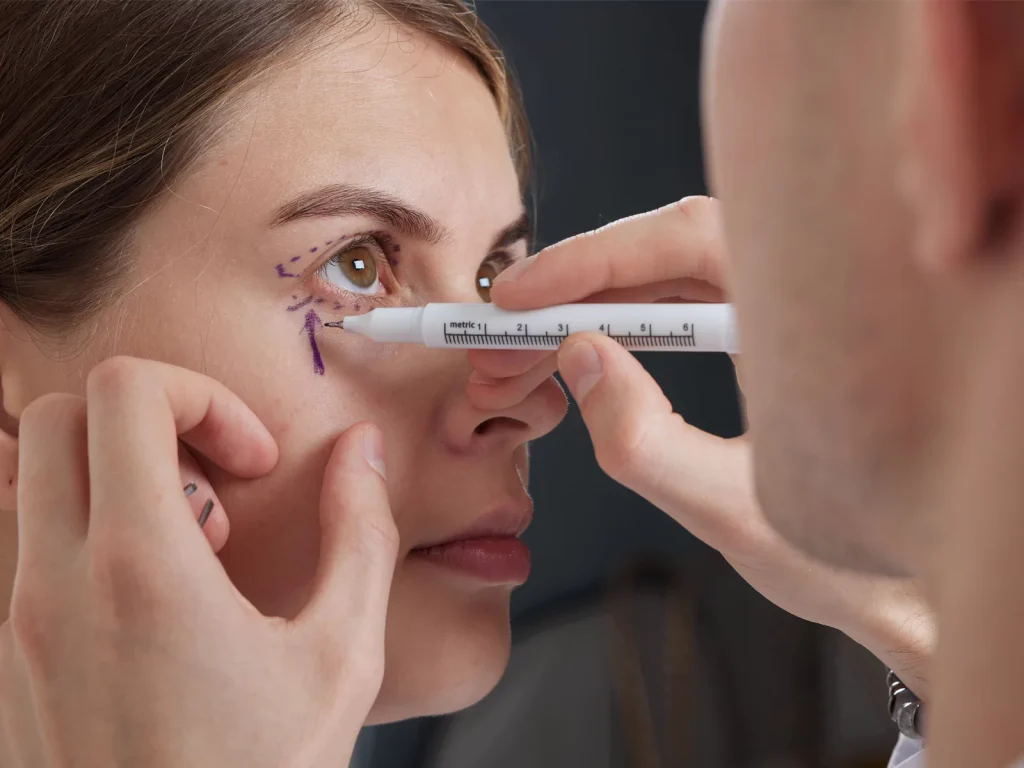
The success of your eyelid surgery is highly dependent on the skill and artistic eye of your surgeon. For those considering this procedure in Iran, we recommend Dr. Armin Akbari, who is widely regarded as the best surgeon for upper and lower blepharoplasty in Iran. As a leading cosmetic surgeon and ENT specialist, he combines technical precision with a deep understanding of facial aesthetics.
Dr. Akbari’s credentials underscore his expertise and commitment to excellence:
- Board-Certified from Tehran University: A mark of his exceptional training and qualifications.
- Member of the Iranian Society of Rhinoplasty and Facial Plastic Surgeons: Reflecting his dedication to the highest professional standards.
- A Record of Over 10,000 Successful Surgeries: A clear indicator of his extensive experience and the trust he has earned from his patients.
To begin your journey toward a refreshed and rejuvenated appearance with a trusted expert, we invite you to get in touch. Please fill out the contact form below to connect with Dr. Armin Akbari and his team. We will contact you shortly to arrange your personal consultation.
Frequently Asked Questions (FAQ)
The procedure itself is not painful as it is performed under local anesthesia with sedation or general anesthesia. Afterward, patients typically report mild discomfort, tightness, or soreness rather than significant pain. This is easily managed with over-the-counter pain relievers like Tylenol.
The results are very long-lasting. The removal of fat pads from the lower eyelids is generally permanent. An upper eyelid lift can last for many years, often 10-15 years or more. While the surgery doesn’t stop the natural aging process, it does effectively turn back the clock.
Surgeons are experts at hiding incisions. For upper blepharoplasty, the scar is hidden in the natural eyelid crease. For lower blepharoplasty, the scar is either just below the lash line or entirely hidden inside the eyelid. Once healed, these scars are typically very faint and difficult to notice.
Most patients feel comfortable returning to work and social activities within 7 to 10 days, once the most noticeable bruising and swelling have subsided. You can typically start wearing makeup again around the 10- to 14-day mark to help conceal any residual discoloration.
Like any surgery, blepharoplasty has potential risks, such as infection, dry eyes, or difficulty closing the eyes. However, when performed by a qualified, experienced surgeon, the risk of serious complications is very low. Your surgeon will discuss all potential risks with you during your consultation.
